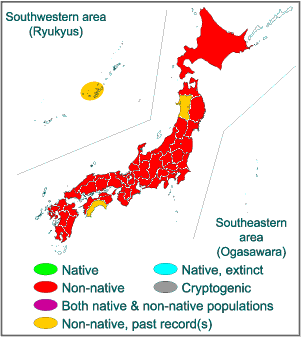| Invasion information |
| Range in Japan |
Almost entire Japan |

|
| Origin |
North America |
| Date |
The first naturalization originated from 12 escaped animals from a zoo in Inuyama, Aichi Pref., in 1962. Since late 1970s, release and escape of pet animals occur throughout the entire Japan, when Procyon lotor was popular as a pet animal probably due to a TV cartoon influence. |
| Route |
Deliberate: Escape from zoo, escape and release of pet animals. |
| Impact |
Predation. Competition. Interference of bird nesting. Damage on agriculture (especially corn). Damage on building structures including cultural properties. Carrying parasites including zoonosis (canine madness, distemper, Stronglyloides procyonis, Baylisascaris procyonis, influenza, Japanese B encephalitis, leptospiruria, spotted fever group rickettsia, salmonella, etc.)
Native organism(s) affected: Native mammals such as Nyctereutes procyonoides and Vulpes vulpes (competition), birds, reptiles, amphibians, insetcts, crustaceans |
| Regulation in Japan |
Import, transport and keeping are prohibited in Japan by the Invasive Alien Species Act. |
| Introduced range in other countries |
Germany, France, Denmark, Netherlands, Belgium, Luxembourg, Switzerland, Austria, Hungary, Poland, Czech, Belarus, Russia, Azerbaijan, Uzbekistan, Bahama Islands, etc. |
| Reference |
Notes |
- Abe (ed) (1994) A Guide to Mammals of Japan. Tokai Univ. Press, Hatano (in Jpn)
- Biodiversity Center of Japan (ed) (2005) Procyon lotor, 7th National Survey on the Natural Environment (Accessed on 2012-6-28) http://www.biodic.go.jp/reports2/7th/araiguma/index.html (in Jpn)
- DECO (ed) (2006) Dictionary of Alien Species. Tokyo-Shoseki, Tokyo (in Jpn)
- Ecol Soc Jpn (ed) (2002) Handbook of Alien Species in Japan. Chijinshokan, Tokyo (in Jpn)
- Ikeda (2000) Toward fundamental management of invasive racoons. Jpn J Conserv Ecol. 5(2), 159-170 (in Jpn)
- Ikeda et al. (2001) Home ranges of invasive raccoons in Nopporo Forest Park. J Coll Dairying, Nat Sci. 25(2), 311-319 (in Jpn)
- JWRC (ed) (2008) A Photographic Guide to the Invasive Alien Species in Japan. Heibonsha, Tokyo (in Jpn)
- Kaneda & Kato (2011) A threat to amphibians and reptiles by invasive alien racoons. Bull Herpetol Soc Jpn. 2011(2), 148-154 (in Jpn)
- Ministry of the Environment, Japan. The Invasive Alien Species Act (Accessed on 2012-6-28) http://www.env.go.jp/en/nature/as.html
- Shiiba Research Forest, Kyushu Univ (2005-2008) Database, Shiiba Research Forest, Kyushu Univ. (Accessed on 2012-3-24) http://www.forest.kyushu-u.ac.jp/miyazaki/index.php?database (in Jpn)
- Long (2003) Introduced Mammals of the World: Their History, Distribution, and Influence. CABI Publishing.
- Ohdachi et al. (eds) (2009) The Wild Mammals of Japan. Shokado, Kyoto.
- Nakamura (1988) Alien Animals of Japan. Kanagawa Pref. Mus., Yokohama (in Jpn)
- Wilson & Reeder (eds) (2005) Mammal Species of the World 3rd ed. Johns Hopkins University Press, Baltimore (Accessed on 2010-12-02) http://www.bucknell.edu/msw3/.
- Yamada et al. (eds) (2011) Invasive Alien Mammals in japan: Biology of Control Strategy and Conservation. Univ. Tokyo Press (in Jpn)
- etc.
|
100 of the Japan’s Wo
rst Invasive Alien Species
|

 Japanese |
English
Japanese |
English